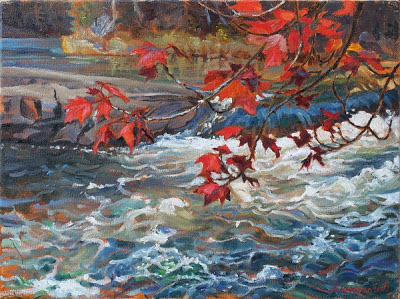Leitrim Roots (oil on canvas 5 x 7 in.)
12 June finds us in the woods of the Letrim Wetland, south of Ottawa. I have settled myself among old fallen branches, to paint a delightful tangle. A Hemlock's roots are embracing those of a Yellow Birch, whose roots, on the other side, flow over an old rotting "nurse log". The evening sun gleams brightly on the Birch's silky, curly bark - not chalky white like Paper Birch, but brightly glossy with an almost metallic, pale brassy-grey sheen that never fails to enchant me.
We entered through a dense stand of Buckthorn on the east side of Albion Road, but the trail that we've followed in past years seems to have disappeared and it's already evening, so we decide not to go farther into the forest. Fred reminds me that it will soon be mosquito time, so I paint fast, starting with a brownish-black underpainting to help me to capture the contrasts of light and dark that are so striking in this scene.
This afternoon we attended a garden party to celebrate the settlement between the developers of Findlay Creek Village and the Appellants (the Greenspace Alliance and Sierra Club Canada) acting on behalf of Leitrim Wetland. The developer will now collaborate with the environmental groups in sustainable management of the water levels in the remainder of this unique wetland as houses are built around it. I have written and illustrated journal pages from my walks in here with Albert Dugal, who has found many rare plants over the course of 20 years of trying to protect the wetland in the face of "development", so I'm pleased to commemorate this occasion with an oil painting.
Even though the mosquitoes this year are much less abundant than most years, my left hand, holding the canvas, is especially vulnerable to their attention, and I begin to pack up. I find three striped (Arion) slugs on the GPS which I'd set on the end of my fallen branch, and two crawling on my paint box. All together, I collect 13 individuals of all sizes within 30 cm of where I've been sitting, and find them very shy upon capture, hunching tightly in a bell-shape and remaining motionless on the lid of my kit. Their bodies are grey, only slightly tinted by the orange slime that sticks to my fingers. I have no idea what species they may be, and may have to dissect them and compare with European specimens in order to find out! While I was painting, Fred poked about under bark and logs, looking for snails. Every time we come here we hope to find more evidence of the large rare native snail Neohelix dentifera that Carolyn Seburn found here in 1995.
This original painting is available for $275. For information on purchase and shipping, please contact me at karstad@pinicola.ca




While these woods and wetlands are famous for their botanical diversity, they are shockingly depauperate herpetologically. When I was looking under logs for Neohelix dentifera, I was also looking for Salamanders, which have never been found here, and it was Salamanders that Seburns, Jennifer, Albert Dugal and I were looking for in 1997 when the Neohelix (the 5th locality for Ontario) was found in 1997. There's not a single species of rare, distinctive, or unusual Amphibian, Turtle, or Snake known from here -- this is presumeably a tribute to the way the site was hemmed in by agriculture in the 19th Century, since the herpetological diversity of wetlands is very largely a function of the area of surrounding uplands that support the populations' activities away from the water.
ReplyDeleteWhile Aleta was painting, I spent most of my time on "Aliens Way" or Albion Road, as it's also called. This artery of incessant noisy traffic runs through a groove in the woods that's walled with the greyish billows of 4-5m tall Frangulous Buckthorn (Rhamnus frangula) which is now in bloom with tiny flowers, and at their feet the spear-tipped half-grown metre-&-a-half-high legions of the invasive Sowthistle, Sonchus palustris, which is not found elsewhere in Canada, and about which governments aren't doing anything. The ditches right along the roads are full of Cattails, some of them the native Typha latifolia, but the majority the European Typha angustifolia, which is so widespread that until recently it was considered a native species. These alien species are like a malignant scar tissue along the gash of the road through the wetland forest, and now that the jurisdictional disputes have come to a resolution, the battle for Leitrim will be with the alien invasive plants.
ReplyDelete